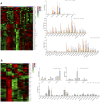Lipotoxic stress alters the membrane lipid profile of extracellular vesicles released by Huh-7 hepatocarcinoma cells
- PMID: 33633289
- PMCID: PMC7907093
- DOI: 10.1038/s41598-021-84268-9
Lipotoxic stress alters the membrane lipid profile of extracellular vesicles released by Huh-7 hepatocarcinoma cells
Abstract
Extracellular vesicles (EVs) are well-known mediators in intercellular communication playing pivotal roles in promoting liver inflammation and fibrosis, events associated to hepatic lipotoxicity caused by saturated free fatty acid overloading. However, despite the importance of lipids in EV membrane architecture which, in turn, affects EV biophysical and biological properties, little is known about the lipid asset of EVs released under these conditions. Here, we analyzed phospholipid profile alterations of EVs released by hepatocarcinoma Huh-7 cells under increased membrane lipid saturation induced by supplementation with saturated fatty acid palmitate or Δ9 desaturase inhibition, using oleate, a nontoxic monounsaturated fatty acid, as control. As an increase of membrane lipid saturation induces endoplasmic reticulum (ER) stress, we also analyzed phospholipid rearrangements in EVs released by Huh-7 cells treated with thapsigargin, a conventional ER stress inducer. Results demonstrate that lipotoxic and/or ER stress conditions induced rearrangements not only into cell membrane phospholipids but also into the released EVs. Thus, cell membrane saturation level and/or ER stress are crucial to determine which lipids are discarded via EVs and EV lipid cargos might be useful to discriminate hepatic lipid overloading and ER stress.
Conflict of interest statement
The authors declare no competing interests.
Figures








Similar articles
-
Phospholipid fatty acid remodeling and carbonylated protein increase in extracellular vesicles released by airway epithelial cells exposed to cigarette smoke extract.Eur J Cell Biol. 2023 Mar;102(1):151285. doi: 10.1016/j.ejcb.2022.151285. Epub 2022 Dec 26. Eur J Cell Biol. 2023. PMID: 36584599
-
Differential Lipotoxic Effects of Palmitate and Oleate in Activated Human Hepatic Stellate Cells and Epithelial Hepatoma Cells.Cell Physiol Biochem. 2016;39(4):1648-62. doi: 10.1159/000447866. Epub 2016 Sep 15. Cell Physiol Biochem. 2016. PMID: 27626926
-
Lipid-Induced Signaling Causes Release of Inflammatory Extracellular Vesicles From Hepatocytes.Gastroenterology. 2016 Apr;150(4):956-67. doi: 10.1053/j.gastro.2015.12.037. Epub 2016 Jan 5. Gastroenterology. 2016. PMID: 26764184 Free PMC article.
-
The emerging roles of extracellular vesicles as intercellular messengers in liver physiology and pathology.Clin Mol Hepatol. 2022 Oct;28(4):706-724. doi: 10.3350/cmh.2021.0390. Epub 2022 Mar 2. Clin Mol Hepatol. 2022. PMID: 35232008 Free PMC article. Review.
-
The Role of Extracellular Vesicles as Shuttles of RNA and Their Clinical Significance as Biomarkers in Hepatocellular Carcinoma.Genes (Basel). 2021 Jun 11;12(6):902. doi: 10.3390/genes12060902. Genes (Basel). 2021. PMID: 34207985 Free PMC article. Review.
Cited by
-
Extracellular Vesicles in Aging: An Emerging Hallmark?Cells. 2023 Feb 6;12(4):527. doi: 10.3390/cells12040527. Cells. 2023. PMID: 36831194 Free PMC article. Review.
-
Lipidic Profile Changes in Exosomes and Microvesicles Derived From Plasma of Monoclonal Antibody-Treated Psoriatic Patients.Front Cell Dev Biol. 2022 Jun 13;10:923769. doi: 10.3389/fcell.2022.923769. eCollection 2022. Front Cell Dev Biol. 2022. PMID: 35769256 Free PMC article.
-
PERK and IRE1α promote exosome secretion via blocking lysosomal degradation of multiple vesicular body.J Biol Chem. 2025 Aug;301(8):110504. doi: 10.1016/j.jbc.2025.110504. Epub 2025 Jul 21. J Biol Chem. 2025. PMID: 40701245 Free PMC article.
-
A Specific Host/Microbial Signature of Plasma-Derived Extracellular Vesicles Is Associated to Thrombosis and Marrow Fibrosis in Polycythemia Vera.Cancers (Basel). 2021 Oct 2;13(19):4968. doi: 10.3390/cancers13194968. Cancers (Basel). 2021. PMID: 34638452 Free PMC article.
-
Comparative and pharmacological investigation of bEVs from eight Lactobacillales strains.Sci Rep. 2025 Jul 26;15(1):27263. doi: 10.1038/s41598-025-12873-z. Sci Rep. 2025. PMID: 40715596 Free PMC article.
References
Publication types
MeSH terms
Substances
LinkOut - more resources
Full Text Sources
Other Literature Sources
Medical
Research Materials

